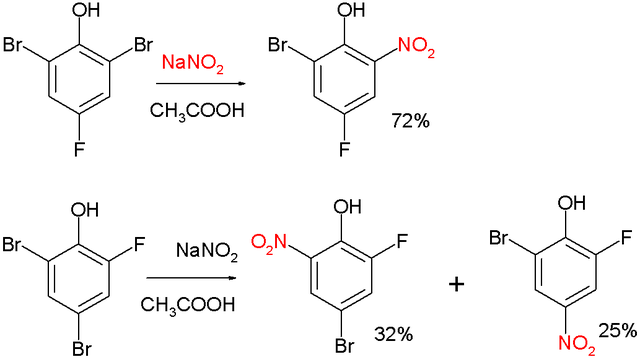\( \require{mhchem} \)
The Zincke nitration is a nitration reaction in which a bromine is replaced by a nitro group on an electron-rich aryl compound such as a phenol or cresol. Typical reagents are nitrous acid or sodium nitrite. The reaction is a manifestation of nucleophilic aromatic substitution and is named after Theodor Zincke, who first reported it in 1900.[1][2]
Two examples:[3]

Zincke nitration (*)
and:[4]

Zincke nitration (*)
The Zincke nitration should not be confused with the Zincke–Suhl reaction or the Zincke reaction.
See also
Menke nitration
References
Zincke, Th. (1900). "Ueber die Einwirkung von salpetriger Säure auf Brom- und Chlorderivate von Phenolen". J. Prakt. Chem. (in German). 61 (1): 561–567. doi:10.1002/prac.19000610145.
Zincke, Th. (1900). "Ueber die Einwirkung von Salpetersäure auf Halogenderivate des p-Kresols". J. Prakt. Chem. (in German). 63 (1): 183–187. doi:10.1002/prac.19010630111.
Raiford, L. Chas.; LeRosen, Arthur L. (1944). "The Nitration of Brominated Fluorophenols by the Zincke Method". J. Am. Chem. Soc. 66 (11): 1872–1873. doi:10.1021/ja01239a020.
Raiford, L. Chas.; Miller, Glen R. (1933). "Behavior of Mixed Halogenated Phenols in the Zincke Method of Nitration". J. Am. Chem. Soc. 55 (5): 2125–2131. doi:10.1021/ja01332a059.
Hellenica World - Scientific Library
Retrieved from "http://en.wikipedia.org/"
All text is available under the terms of the GNU Free Documentation License

